Founded 1218 Date dissolved 1886 | 1298–1311 (first) Garaad Dhidhin Established 1218 Capital Las Khorey | |
Warsangali sultanate
The Warsangali Sultanate (Somali: Saldanadda Warsangeli, Arabic: سلطنة الورسنجلي) was a Somali imperial ruling house centered in northeastern and in some parts of southeastern Somalia. It was one of the largest sultanates ever established in the territory, and, at the height of its power, included the Sanaag region and parts of the northeastern Bari region of the country, an area historically known as Maakhir or the Maakhir Coast. The Sultanate was founded in the late 13th century in northern Somalia by a group of Somalis from the Warsangali branch of the Darod clan, and was ruled by the descendants of the Garaad Dhidhin. In the late 19th century, the influential Sultan Mohamoud Ali Shire governed the Sultanate, assuming control during some of its most turbulent years. The Akil Dhahar ruled south of Sanaag and some portions of the Bari region. In 1884, the United Kingdom established the protectorate of British Somaliland through various treaties with the northern Somali sultanates, including the Warsangali Sultanate.
Contents
- Warsangali sultanate
- Akil Dhahar
- Northern Somali sultanates
- Somali British treaties
- Civilization society and Islam
- Warsangali Dervish collaboration
- Exile
- Timeline of events in northern Somalia
- Rulers of the Warsangali Sultanate
- References
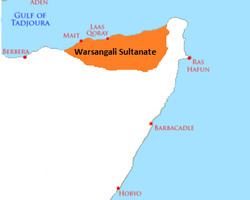
Akil Dhahar
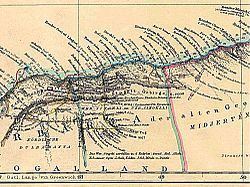
Although there is a dearth of historical testimony on Akil Dhahar, according to oral tradition, he fought against the Abyssinians. In honor of his accomplishments, Akil Dhahar's name is immortalized in the valley and mountains of the city known as Dhahar.
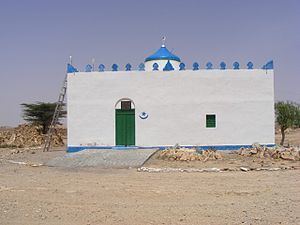
I. M. Lewis, in his book A Pastoral Democracy: A Study of Pastoralism and Politics Among the Northern Somali of the Horn of Africa, refers to the Sultan from the colonial literature as a "man of unusual influence", a "man of mercurial image", and a "man of unusual strength". Several Somali Sultanates existed in Somalia prior to the European imperialism of the 19th century, but the Warsangali Sultanate was the only one with a robust tax-based centralized administration. Lewis writes:

Vestiges of a similar degree of centralized administration on the pattern of a Muslim Sultanate, survive today in the Protectorate among the Warsangali. Prior to 1920, the Garaad had at his command a small standing army with which, with British support, he fought Sayyid Mahamad Abdille Hassan's forces. But Garaad's powers' are dwindling under modern administration.
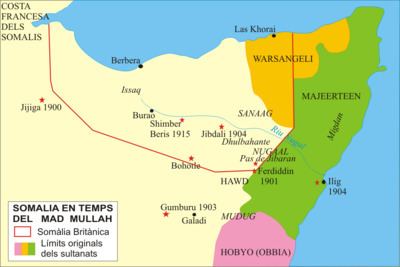
Sultanates such as these, generally only arose on the coast or through commanding an important trade route, and were largely dependent on the possession and control of a port or other exploitable economic resources. They were in direct trade and diffuse political relations with Arabia, received occasional Arab immigrants, and were the centres from which Islam expanded with trade into the interior. The Sultanates had to fight to maintain their positions of supremacy against the periodic incursions of raiding parties of nomads, and their authority was never great.
Northern Somali sultanates
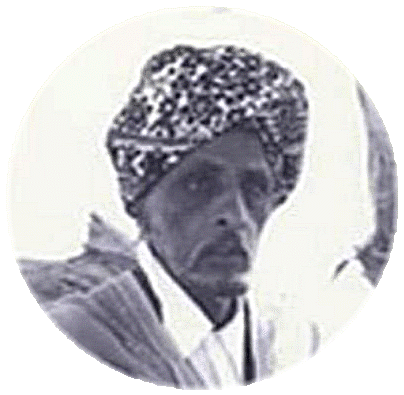
In 1896, a challenge of leadership emerged between a father and son. The powerful Garaad Ali Shire's authority was dwindling and young Mohamoud Ali Shire, with the tacit support of the Isse Garaad (Bohogayslabe) sub-clan of the Warsangali Darod, sought to undermine the power of his father. Before then, internal conflict among the Warsangali sub-clans had surfaced and had had an effect on Sultan Mohamoud Ali Shire and his ascension to power. The disarray caused by the young Mohamoud among the Warsangali was finally settled by the proposal that Mohamoud fils should become Sultan, while his father could remain Garaad. The Bihidor sub-clan of the Warsangali, however, withdrew their support for the Sultan, deeming him an upstart and an untested authority figure. They subsequently forged an alliance with the Somali religious and nationalist leader Mohammed Abdullah Hassan's Dervish forces in an attempt to defeat Britain and Ethiopia, two powers that were then also vying for control of the Somali Peninsula. In his paper The 'Mad Mullah' and Northern Somalia, the historian Robert L. Hess touches upon this alliance, writing that "in attempt to break out of Obbian-Mijertein circle, the Mullah sought closer alliances with the Bihidor Warsangali of British Somaliland and Bah Geri of Ethiopia".

Following an unexpected onslaught, the Sultan ordered his army to retreat from its main military posts in Erigavo, a town that at the time served as a reserve well for the Sultan's horses and as a base for his army. Hassan's alliance with the Bihidor clan was instrumental in extending the Dervish sphere of influence and in expanding his Dervish State's hegemony. On 3 March 1905, Italy came close to signing a treaty with Hassan at Illig, offering him the Nugaal territory as a protectorate. Hassan, however, rejected the offer and his Dervish army continued its anti-imperial resistance struggle. In its early proposal, both the Majeerteen and Warsangali Sultanates also opposed the treaty, as they foresaw potential threats to their own local authority from its hypothetical implementation. These Sultanates thus collaborated to defeat the Dervish forces:
The first success in this Anglo-Italian cooperation came in December 1910. In that month, the British Warsangali and the Italian Mijertain peacefully resolved all their outstanding disputes and, convening in Bander Kasim, agreed to act jointly in combating Sayyid Mohammed Abdullah Hassan and his Dervishes. The Mijertain–Warsangali Accord led to a common offensive against the Mullah, whose forces were cut off from arms and munitions smuggled in from the coast. (Hess, 427) In 1920, the Dervishes unexpectedly captured Badhan and besieged Las Khorey. The British Governor at Aden soon sent RAF biplanes to contain the advance of the Dervish army into the Warsangali country. Though the air strikes that bombarded Badhan, Jidali and Talex never did considerable harm to the Dervishes, the Dervishes were still powerful but disorganized and dispersed into unknown areas. Finally, the forces of Warsangali and Dervishes met at Jidali and this was in fact the final decimation of the Dervish movement.
The Mijertein Somalis, who in June succeeded launching counter-attack with the aid of their Warsangali allies..Mullah and his followers were driven out of Italian Somaliland into British Somaliland, where they occupied Buhotleh with great cruelty and oppressed the Dolbahante who had shifted their allegiance back to British Somaliland.
As a result, the Dervishes abandoned the Nugaal territory and retreated into the Hawd.
Somali-British treaties
Historically, the British used indirect rule to their advantage to control and exploit territories. Following the British treaty with the Warsangali in 1886, the British Somaliland protectorate was formed. Much of the territory's economy at the time was centered on the trade relationship it had with Aden, Yemen, which was chiefly based on the export of livestock, frankincense, and myrrh in return for food, fabric, and other materials. The protectorate was subsequently administered from Aden until 1898, just before the rise to prominence of Sayyid Muhammad Abdullah Hassan.
The British realized that isolated efforts to pacify Somali authority with treaties were not sufficient, and that doing so could incite trouble within the protectorate. In 1884, the British government thus signed protection treaties with the Issa, Gadabuursi and Isaaq Somali clans, all at once. This particular tripartite agreement was beneficial to the British, as it permitted them to operate harmoniously alongside the existing clan social systems of northwestern Somalia. However, Sultan Mohamoud Ali Shire and his administration in the northeastern part of the Somali territories wielded enough power to continue to exercise independent operation and rule. Article V of the British treaty with the Warsangali acknowledges this continued sovereignty of the Warsangali territories, adding that the British government appointed an ambassador to the region and was in the process of building an office there:
Another Article of the treaty between the Warsangali and the British highlights the independence of the Warsangali from colonial interference vis-a-vis their territories:
Civilization, society and Islam
The ascendancy of Somali society in terms of trade, civilization and contact with ancient pharaohs continued for many centuries. In northern Somalia, which is believed to have been the location of the famous Land of Punt, existed numerous notable examples of sophisticated architecture, agricultural innovation and civil engineering. Irrefutable evidence is the existence of 15 storey towers in Las Khorey that were built during the Garaad dynasty. Materials used in the local Somali architecture included, among other things, a specific type of wood:
The gum-producing trees grow on the sterile hills near the coast in the Sanaag and Bari regions. In this districts there also grows a tree known in Somali as 'damask', a species of willow valuable for house- and boat-building purposes. It grows along the banks of the 'tugs' or dry water-courses that in the rainy season drain the interior. (Burale).
Islam was introduced into the Sanaag region as early as the 7th century, with most of the area's inhabitants following the Shafi'i madh'hab of Sunni Islam. Thus, it appears that Sufism and saint veneration, the mystical movement and ecstasy in Islam, was embraced among the Warsangali clans of Sanaag and spread to other areas of Somalia. For instance, Haylaan, a small town located 20 km south of Badhan, houses the sepulchre of Darod Ismaiil, the founder of the Darod clan. The Somali scholar Said Ali Nur indicates that regions such as Zeila, Sanaag and Harar became centers of dispersal for the founders of many Muslim communities in the Horn. In fact, the founder of the Darod clan is venerated as a saint by many members of said clan. This sort of veneration is internalized in the customs of all Somalis, and these figures are known as "ancestor saints". Through them, man's appeal to the mercy and blessings of God is strengthened. Although these saints are respected, due to their intermediary role, they themselves are not directly worshipped. The Elaayo mosque where, among other masjids, actual worship took place, still stands with remarkable structural strength, almost entirely marble.
Initially, due to their many ancient settlements, the northeastern cities of Las Khorey and Elaayo formed a growing international hub and served as important destinations. The Sultan's revolt against the British, however, led to the ultimate decline of these coastal areas, as the British then shifted their administration to the western side of northern Somalia. The erstwhile commercial centers of Las Khorey and Elaayo consequently diminished in importance.
Moreover, according to historical testimony by the British Lieutenant John Hanning Speke in his journal What led to the Discovery of the Source of the Nile, published some 31 years before the Somali-British treaty of 1886 wherein the English agreed to provide military and logistical support to the Isaaq near Aden in Yemen, the decline in power of the Warsangali Sultanate began thus:
Speke also discussed the relative strength of the Sultanate's administration, opining that Garaad Mohamoud Ali was a capable leader:
Warsangali-Dervish collaboration
The two Somali leaders, Sultan Mohamoud Ali Shire and Sayyid Muhammad Abdullah Hassan, were in the spotlight. The British Somaliland protectorate's administration had dealt with each one of them secretly, and had worked to prevent a possible bilateral alliance of power-sharing and common economic and political integration on their part. A notable incident took place in 1908, when British airplanes bombarded Jidali, Badhan and Taleex. This led to the dispersal of the Dervish into many areas, and it took a long period for the Sayyid to recoup his strength. However, despite the rift between them, Sultan Mohamoud Ali Shire and his army within the British Somaliland protectorate's claimed areas of Sanaag were severely disturbed by the sudden ebb in Dervish activities. To demonstrate his concern, Sultan Shire ordered his army to open fire on a British ship that was about to land at the port of Las Khorey. I. M. Lewis cites this brief incident in his book, A Modern History of the Somali:
The Warsangali clan within the British protectorate on the eastern coast who under their spirited leader Garaad Mahamud 'Ali Shire had now decided to throw in their lot with the Dervishes and in January 1908, fired on a British dhow as it was landing on their coast. This incident has led to a hostile exchange of letters with the consul at Berbera and it was evident that the Dervishes would soon be on the March again.
Furthermore, Hassan's association with Mohamoud Ali Shire as brother-in-law gave him access to the Maakhir Coast, which served as a gateway to the Arabian peninsula for the importation of firearms and ammunition. The Dervishes thus resumed their movements, which rendered the British nervous, especially since their alliance with the Isaaq forged in a treaty from 1885 had proved ineffectual.
The British ran out of options and were forced to collaborate with the Italians and the Majeerteen Sultanates for an attack that forced the Dervishes from their main strongholds such as Taleex and Jidali. Sporadic resistance using guerrilla tactics ensued. However, while Sultan Mohamoud Ali Shire's government was feared by the British and many Somali clans, some Warsangali sub-clans also viewed the Sultan's government with suspicion because of its authoritarianism. They consequently declared independence from his dominions, and began a rebellion to topple the leader. This internal conflict among the Warsangali sub-clans coincided with the Dervishes' struggle to expel the British and Italian imperialists. In an attempt to lure supporters to side with him, the Sayyid composed a poem for this incident:
The Sultan's troops killed many men of the Bihidoor clan, a subclan of the Warsangali. According to testimony by John Hanning Speke in his journal and elders of the Warsangali sub-clans, this led to defiance and hostility on the part of the Bihidoor. Members of the Bihidoor nonetheless settled in Xiingalol, which was then the most populous city in Sanaag, as well as in the long plateau of Xadeed in large numbers.
Exile
Despite a lack of stability and struggles with the imperialists, Sultan Shire was secretly invited to a conference in Yemen, ostensibly to discuss possible ways of settling differences. After a short session before the meeting was scheduled to begin, he was taken into custody by the British authorities. Sultan Shire was later tried without proper representation in a kangaroo court. Due to the Sultan's vehement and active opposition to foreign rule over his territory and dread on the part of the British of the prospect of another twenty years of costly and protracted battles with yet another Somali potentate, he was sentenced to exile in the Seychelles for a period of seven years (a place where the British often confined prominent anti-imperialist leaders). However, Shire continued to play a prominent role in local affairs until his eventual death a few months after independence, as the British administration sought his support before introducing any major policy changes so as to avoid alienating the influential leader.
Timeline of events in northern Somalia
Rulers of the Warsangali Sultanate
Rulers of the Warsangali Sultanate up to and after Sultan Mohamoud Ali Shire:
